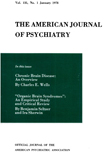Abnormal Movements and Prognosis in Schizophrenia
Abstract
A longitudinal study was made of 18 young hospitalized schizophrenics who exhibited abnormal movements of a choreiform or athetoid type and 36 schizophrenic controls who were free of movement disorders. The group with movement abnormalities were younger at first hospitalization than the controls and their disease progressed steadily, with early and profound mental deterioration. The majority remained in the hospital for the entire observation period despite intensive treatment efforts, while the control group had shorter hospital stays and showed better treatment response.
Access content
To read the fulltext, please use one of the options below to sign in or purchase access.- Personal login
- Institutional Login
- Sign in via OpenAthens
- Register for access
-
Please login/register if you wish to pair your device and check access availability.
Not a subscriber?
PsychiatryOnline subscription options offer access to the DSM-5 library, books, journals, CME, and patient resources. This all-in-one virtual library provides psychiatrists and mental health professionals with key resources for diagnosis, treatment, research, and professional development.
Need more help? PsychiatryOnline Customer Service may be reached by emailing [email protected] or by calling 800-368-5777 (in the U.S.) or 703-907-7322 (outside the U.S.).



